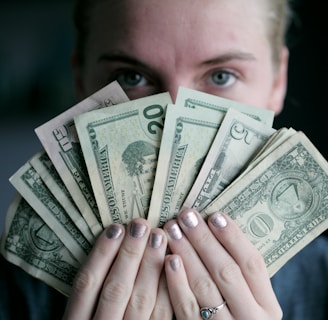Turn Side-Hustle Money into Wealth: Beginner Investing Apps that Work Even When You’re Not Working
Learn how to invest your side hustle income with just $10/week using beginner-friendly apps. Discover the power of dividends, DRIP, and long-term wealth building—no financial background required.
Rob
7/18/20256 min read


Turn Side-Hustle Money into Wealth: Beginner Investing Apps that Work Even When You’re Not Working
Strengthen Your Mind. Build Your Future
First I need to say this. I am not a financial planner or advisor. Do your own research and homework and decide which financial decisions are right for your individual needs. Next, get a professional financial planner or advisor to handle your money if you do not feel like you have the knowledge or skill to do so. Be careful because there are good ones and bad ones so get references and find one you trust. Now, let's get started.
You don’t need thousands to invest. You need a strategy and about ten bucks.
Most people think investing is for the wealthy. But the truth is, you can start growing wealth with as little as $10 a week. You don’t need a financial degree, insider tips or a six-figure salary. You just need the willingness to start.
If you’re running a side hustle or generating extra income whether it’s $50 a month or $500, the smartest move you can make is to let your money earn more money. It’s time to let your money work for you because you know you have had to work hard for it.
Because when you invest early and consistently, even in small amounts, you can build the kind of wealth that changes your future.
Easy-to-Use Investing Apps That Make It Simple
There are probably hundreds of apps out there, but here are five beginner-friendly platforms worth considering:
1. Acorns
Round-up app that automatically invests spare change.
Great for total beginners who want to automate everything. Be mindful of the $3–$5 monthly fee, It can eat away at small balances.
2. Robinhood
Commission-free stock and ETF trading.
Great for hands-on learners who want control.
Risky if you chase trends, but use it for long-term ETFs, not meme stocks.
3. Fidelity or Schwab
Traditional brokerages with robust mobile apps and zero-fee funds.
Great for building long-term portfolios or Roth IRAs.
Offers automatic DRIP (more on that in a minute).
4. SoFi
All-in-one financial app with investing, loans, banking and career coaching.
Great for holistic financial planning. (A holistic planner helps you prioritize what matters to you, with a strategy that fits your stage of life, risk tolerance, values, and goals.)
5. Public
Combines investing with a social feed to learn from other investors.
Great for: Beginners who want to follow and learn from others.
Don’t confuse popular with profitable, do your research.
What Are Dividends and Why Should You Care?
Dividends are cash payments companies give you just for owning their stock. Dividend payments are scheduled by the Board of Directors of each company. They could be quarterly, monthly or twice a year, depending on the Board of Directors’ decision.
Think of it like a thank-you check for investing in them.
Let’s say you own 10 shares of a company that pays $1 per share in annual dividends. That’s $10 you’ll get just for holding the stock.
Now, multiply that over years and turn on DRIP (Dividend Reinvestment Plans) and those payouts are used to buy more shares automatically. That means every dividend grows your ownership and future income, creating compound growth automatically without you having to do anything.
Over time, this steady snowball effect can significantly increase the value of your retirement account or investment portfolio even without adding more cash yourself.
Who Are the Dividend Kings?
Dividend Kings are elite. They’ve increased their dividend payouts for 50 years or more, through recessions, wars and market crashes.
Here are just a few with their stock symbols:
Coca-Cola (KO)
Johnson & Johnson (JNJ)
Procter & Gamble (PG)
3M (MMM)
Lowe’s (LOW)
Hormel Foods (HRL)
Colgate-Palmolive (CL)
Genuine Parts Company (GPC)
Target (TGT)
These aren’t exciting high-growth tech stocks. They’re boring and that’s the point. They’re predictable, resilient and cash-rich.
When you reinvest their dividends through DRIP, you can grow your portfolio without spending another dime. Over decades, this is how portfolios become income machines, perfect for retirement planning.
Here’s a real life example looks like and what a steady investment looks like, assuming 7% annual return:
$10/week → ~$7,200 after 10 years
$20/week → ~$15,000
$50/month → ~$9,000
If you’re investing in dividend-paying stocks with DRIP turned on, your total return could be even higher.
Should You Work with a Financial Planner?
If you're just getting started, investing with an app is a great first step. But as your portfolio grows or if you're unsure where to begin a certified financial planner (CFP) can be a game-changer.
A good financial planner helps you:
Set long-term goals (like retirement, home ownership or college funds)
Build tax-efficient strategies. There is no need to give Uncle Sam any more in taxes than what we have to give. Your financial planner may be able to give you tips on what to look out for and how to avoid some pit falls.
Avoid common investment mistakes. When you are new to anything mistakes occur because of inexperience so that is why it is wise to have a financial planner to guide you and give you advice that can literally affect your life in the future.
Balance risk and diversification. Keeping a good balance with your investments in your portfolio can be a substantial help when something happens in the economy to cause it to fluctuate and maybe the stock market takes a hit but your real estate investment is on the rise. There are so many ways to invest and diversify your investments, please look into ways that interest you where you can have a strong return.
Think of a financial planner like a personal trainer but for your money.
You don’t need one to get started, but as your financial life gets more complex, it’s wise to have an expert in your corner.
Jay-Z’s Story
The rapper/business man, Jay-Z didn’t just earn money from music. He built an empire by reinvesting into companies like Uber, Tidal, and Armand de Brignac champagne.
He once said:
“I’m not a businessman. I’m a business, man.”
He turned active income into long-term ownership.
You can do the same with your side hustle cash, starting with $10, some consistency and the right mindset.
What is your next step?
Choose an investing app from the list
Set up automatic weekly deposits
Invest in quality, mutual funds and after a while then invest in dividend-paying stocks
When applicable turn on DRIP and let the compounding begin
You’re not just saving money, you’re building your future. Take a percentage of your side-hustle money and invest it. Into YOUR future the payoff you will receive from that one decision could make you very comfortable, financially, in years to come.
Ready to take the next step? If you haven't opened up a new account and built your profile with at least one of these apps, that is your next step. If you have but you have yet to start investing, then that is your next step. Whatever your next step is, take it and keep moving forward. Your future self will thank you for it. In 1 year, 2 years, 5 years, what if you look back and think to yourself, "Why didn't I just start?" But what if you did start and continued to invest and now in 1-5 years you look back and have a great feeling about yourself and you are proud of yourself for starting. You have a piece of mind. You have a sense of accomplishment and you are still progressing. Isn't that the way you want to feel?
In the next post, we’ll show you how to turn your skills into a digital product and create scalable income.
Until then, keep strengthening your mind and building your future.
Thank you for stopping by,
-Rob








Knowledge = Strength
Empowering individuals through accessible business insights.
Inspire
Educate
info@muscleforthemind.com
© 2025 All rights reserved.
